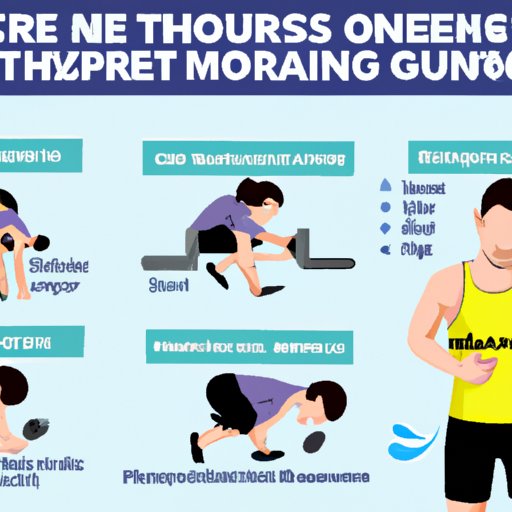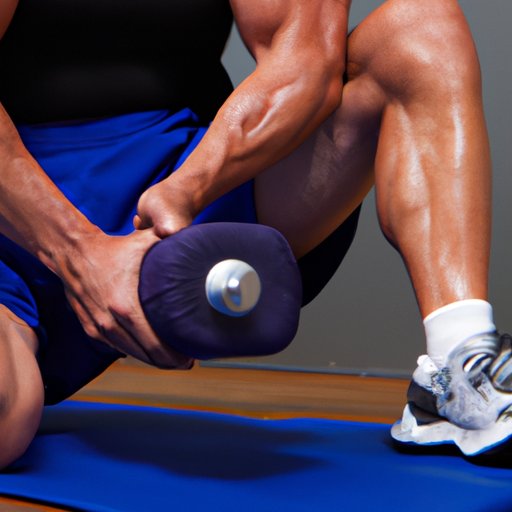Introduction
Working out sore muscles is a common practice among athletes and fitness enthusiasts. But is it really okay to work out sore? In this article, we will explore the benefits, tips and tricks, and science behind working out sore muscles safely and effectively.

Definition of Working Out Sore Muscles
Working out sore muscles refers to exercising when your muscles are already sore from a previous workout. Many people believe that this can help speed up recovery, as well as improve performance. However, it is important to note that working out sore muscles can be dangerous if done incorrectly.
Overview of Benefits of Working Out Sore Muscles
There are many potential benefits to working out sore muscles. These include improved muscular endurance, increased flexibility, enhanced recovery, and improved body awareness. Additionally, working out sore muscles can also help reduce muscle pain and stiffness, and make workouts more enjoyable.
How to Work Out Sore Muscles Safely
It is important to take certain precautions when working out sore muscles. The following tips can help ensure you stay safe while still reaping the benefits of working out sore:
Warm Up Properly
Before beginning any workout, it is important to warm up properly. This helps to prepare your body for the upcoming activity and prevent injury. When working out sore muscles, it is especially important to spend extra time on the warm-up, as this can help reduce the risk of further injury.
Use Proper Form
Proper form is key when it comes to any type of exercise, but it is especially important when working out sore muscles. Using proper form will help ensure you are targeting the correct muscles and performing exercises correctly. Additionally, using proper form can help reduce the risk of further injury.
Choose Appropriate Exercises
When working out sore muscles, it is important to choose exercises that are appropriate for your current level of fitness. Avoid exercises that involve high-impact movements or require large amounts of weight, as these can put unnecessary strain on your already sore muscles. Instead, focus on low-impact exercises that target the same muscles without putting too much strain on them.
Increase Intensity Gradually
When working out sore muscles, it is important to increase intensity gradually. Start with light exercises and gradually work your way up to more intense exercises. Doing so will help ensure you don’t overdo it and risk further injury.

What to Expect When Working Out Sore Muscles
When working out sore muscles, there are a few things you should expect. These include:
Soreness May Last Longer
When working out sore muscles, it is likely that the soreness will last longer than usual. This is because your body is already in the process of repairing itself from the previous workout. As such, it may take longer for the soreness to subside.
Delayed Onset Muscle Soreness
Delayed onset muscle soreness (DOMS) is a common side effect of working out sore muscles. DOMS is a type of muscle soreness that occurs 24-48 hours after a workout. This is caused by microscopic tears in the muscle fibers and can last for several days. DOMS is usually not serious and usually subsides within a few days.
Increased Performance Over Time
One of the benefits of working out sore muscles is that you can expect to see an increase in performance over time. This is because your body is better able to handle the increased workload and is better adapted to the exercises you are performing. Additionally, working out sore muscles can help you build muscle faster, as it forces your body to repair itself faster.
Common Misconceptions About Working Out Sore Muscles
There are several misconceptions about working out sore muscles that need to be debunked. These include:
That It’s Unhealthy
Many people believe that working out sore muscles is unhealthy, but this is not true. Working out sore muscles can actually be beneficial if done correctly and with proper caution. As long as you are taking the necessary precautions to stay safe and healthy, there is no reason why you can’t reap the benefits of working out sore.
That It Will Lead to Injury
Another misconception about working out sore muscles is that it will lead to injury. This is not necessarily true. As long as you are using proper form, increasing intensity gradually, and choosing appropriate exercises, you should be able to avoid injury while still gaining the benefits of working out sore.
That You Shouldn’t Push Through the Pain
Finally, some people believe that they should never push through the pain when working out sore muscles. While it is important to listen to your body and take breaks when necessary, pushing through the discomfort can help strengthen your muscles and improve your performance.
Tips and Tricks for Working Out Sore Muscles
The following tips and tricks can help you make the most of your workouts when working out sore muscles:
Stay Hydrated
Staying hydrated is essential when working out sore muscles. Dehydration can lead to fatigue, which can make it difficult to complete your workout. Be sure to drink plenty of water before, during, and after your workout to keep your body hydrated.
Get Enough Rest
Getting enough rest is also important when working out sore muscles. Make sure to get at least 8 hours of sleep each night and take rest days when necessary. This will help ensure your body has enough time to recover between workouts.
Eat a Balanced Diet
Eating a balanced diet is essential for maintaining good health and recovering from workouts. Make sure to eat a variety of fruits, vegetables, whole grains, and lean proteins to give your body the nutrients it needs to stay healthy and strong.
Use Heat or Ice Therapy
Using heat or ice therapy can also help reduce muscle pain and stiffness when working out sore muscles. Heat therapy increases blood flow to the affected area, while cold therapy reduces inflammation. Both can be beneficial for reducing muscle soreness and improving recovery.

Common Mistakes to Avoid When Working Out Sore Muscles
When working out sore muscles, there are certain mistakes to avoid. These include:
Ignoring Pain
It is important to listen to your body and pay attention to any pain or discomfort you may be feeling. Ignoring pain can lead to further injury and can also impede your progress. If you experience any pain or discomfort, take a break and consult a doctor if necessary.
Overtraining
Overtraining can be dangerous when working out sore muscles. Make sure to take rest days and allow your body time to recover between workouts. Additionally, it is important to listen to your body and adjust your intensity accordingly.
Not Listening to Your Body
Finally, it is important to listen to your body and be aware of any signs of fatigue or pain. Pushing yourself too hard can lead to further injury and can impede your progress. Pay attention to how your body is feeling and adjust your intensity accordingly.

The Science Behind Working Out Sore Muscles
Understanding the science behind working out sore muscles can help you make informed decisions about your workouts. Here is a brief overview of the causes of muscle soreness and how exercise can help improve muscle strength and endurance:
Causes of Muscle Soreness
The cause of muscle soreness is usually due to microscopic tears in the muscle fibers. This occurs when the muscle is pushed beyond its normal capacity and can result in delayed onset muscle soreness (DOMS). DOMS typically occurs 24-48 hours after a workout and can last for several days.
How Exercise Improves Muscle Strength and Endurance
Exercise helps to improve muscle strength and endurance by forcing the muscles to adapt to the increased workload. When the muscles are pushed beyond their normal capacity, they must repair themselves in order to become stronger and better adapted to the exercises. Over time, this can lead to improved performance and a greater ability to handle higher levels of intensity.
Conclusion
Working out sore muscles can be beneficial if done correctly and with proper caution. There are many potential benefits to working out sore muscles, including improved muscular endurance and flexibility, enhanced recovery, and improved body awareness. Additionally, there are tips and tricks you can use to make the most of your workouts and avoid common mistakes. Finally, understanding the science behind working out sore muscles can help you make informed decisions about your workouts.
(Note: Is this article not meeting your expectations? Do you have knowledge or insights to share? Unlock new opportunities and expand your reach by joining our authors team. Click Registration to join us and share your expertise with our readers.)
